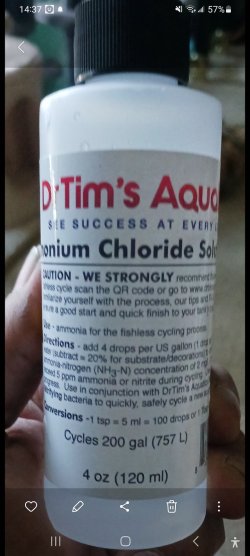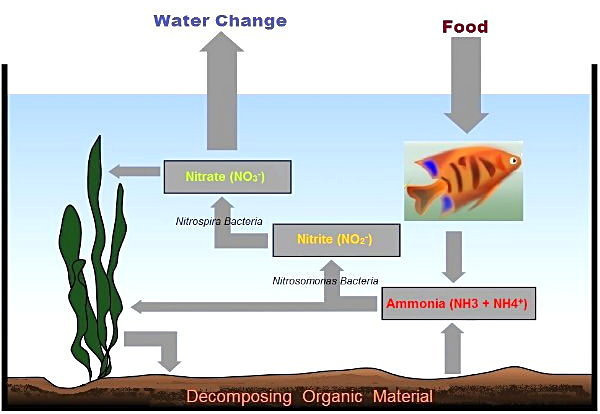A bit of misinformation in this thread.
It is important to understand some things here that were either misstated or omitted.
There are two brands of ammonium chloride for hobbyists of which I am aware that allow one to dose properly. One is Dr. Tim's One and Only and the other is Fritz's Fishless fuel. If you use either one of these, follow the directions for using it. But, there is another factor to consider when doing so.
I use the dry form of ammonium chloride sold by Fritz and I mix my own solution. That said, we need to understand that there are two scales used to measure the 3 nitrogen compounds of which we need to be aware. One scale is favored by science and it the Nitrogen scale. Using that scale all that gets measure is the Nitrogen and the other components are ignored. The other scale is the one most common in our hobby test kits. This is the Total Ion Scale and it measures all the parts of of each of those 3 things. But just like one can convert miles to kilometers, gallons to litres, inches to centimeters etc., there are conversions for the 3 nitrogen compounds.
A full explanation and the conversion factors can be found here:
https://www.hamzasreef.com/Contents/Calculators/NitrogenIonConversion.php
I have never used the Fritz liquid product but I know that both their dry version and the Dr. Tim's both use the Nitrogen scale. Based on the fact that both Dr. Tim's and the Fishless fuel both use 4 drops/gallon, I assume that the Fritz Fishless Fuel is also likely using the Nitrogen scale.
The fishless cycling article here recommends using 3 ppm on the Total Ion scale for cycling. 2 ppm of ammonia on the nitrogen scale is equal to 2.56 ppm on the Total Ion scale. So, each single drop of the products should produce about .64 ppm on the Total Ion scale. If one increases the dose to 5 drops/gal., the result would be 3.2 ppm on the TI Scale
If one is a real accuracy nut you can calculate things for yourself to produce 3.0 on the Total Ion scale unless you have a small tank. If one is using ammonia rather than the ammonium chloride, you can get things more exact. But, you can work with either form- ammonia or ammonium. However, if you use the ammonium chloride products to dose 4 drops you will be reaching fewer than 3 ppm and if you use 5 you will get a bit over 3 ppm. For the cycling method here this would mean you will hit the numbers for the next additions of ammonia a bit more quickly or slowly than if you had dosed exactly 3 ppm. However, you can still use the guide here and it will work OK with either 4 or 5 drops/gallon.
Finally, if you read the directions for Dr. Tim's product you will note that it states one can use ml to dose in larger tanks. 1 ml of the product will produce the 2 ppm-N of ammonia, or the 2.56 ppm on the T. I. scale, in 20 gallons (75.7 l) of water . That makes it lot easier than having to add 20 x 4 = 80 drops. I buy disposable 1 and 3 ml pipettes for a few pennies in boxes of 200. Smaller numbers might cost as much as 10 cents apiece. Dosing in those 1 ml increments makes it much easier to treat larger tanks. I make up packets which hold 5 x 1 ml and 5 x 3 ml of the pitpets along with a small candy cane which I pass out at the December Xmas meeting of my fish club.
Next, the bacteria do not need to be fed every day. They do just fine missing a day or two. But, if the ammonia is no longer available, they do not die. What happens is that they go into a state of dormancy. Here is how Dr. Hovanec explains it:
How can bacteria live in a bottle and not die for 6 months or a year?
A common misconception about bacteria in general is that they die if they are not fed. From a human being point of view this sounds perfectly reasonable: if you don’t eat, you die. However, bacteria are not human beings. Bacteria operate much differently than people and have a variety of ways to deal with those times when resources are not available for them to grow and reproduce. Some bacteria when stressed (from say lack of nutrients) form spores and go into a resting stage, waiting for conditions to improve. Nitrifiers do not form spores but have other mechanisms to deal with nutrient deficient periods. For nitrifiers, one way to deal with stressful conditions is to form a protective “shield” called EPS. EPS stands for extracellular polymeric substances and is, in simplistic terms, an organic protective shield that research shows inhibits various organisms from attacking and breaking open the cell wall of nitrifiers. Nitrifiers belong to a very old line of bacteria (millions of years) and they have developed ways to cope with very long periods of “drought.” Because the nitrifiers in DrTim’s One & Only are grown on a substrate, they can form EPS when needed and last 6 to 12 months in a bottle.
More specifically, the bacteria can sense when ammonia is gone and in response they basically greatly slow down. They are not dead but are more more like being in suspended animation. They can survive in this state for some time. But when ammonia is again available, they "wake up" and get back to work. Different strains of the the ammonia bacteria can stay more or less viable such that the time to resuming full activity can vary. What also matters is the condition of the bacteria when they go dormant. If they have been well fed the time to recovery will be faster and more efficient. Also, the difference in the level of ammonia any strain needs to thrive matters. Those strains which need low levels of ammonia tend to last longer and revive sooner.
But, there is more to the survival strategies of the bacteria than just going dormant. Some small percent of the bacteria are normally motile. How much bacteria may be so depends on the availability of nitrogen. When the conditions which will cause most of the bacteria to go dormant is present, the percent of the bacteria that becomes motile can be up to 10%. The job of these bacteria is to swim to other locations where the needed nutrients are available and where they can then form new colonies.
So, the way the nitrifiers have managed to survive for many millions of years is a combination of most of them being able to go dormant and for some of them being able to move to other locations where what they need is present. This is why they can survive extended bad times without being able to form spores as strategy for doing so.
So, in our tanks if there is no ammonia (or nitrite) available for the bacteria, they do not die. The difference between what happens in a tank v.s. in the wild is that there is no place for the motile ones to go to find better conditions. They are stuck inside the tank. But the rest of the established colonies spread around a tank and in the filter can go dormant and they will when they need to do so.




